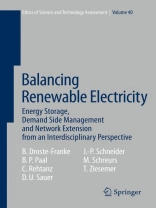An important aim behind the restructuring of Germany’s and Europe’s electricity systems is to reduce the environmental burden, especially with respect to greenhouse gas emissions, of the current systems. Emissions must be brought down to a level that is sustainable in the long run and consistent with greenhouse gas emission reduction goals. Meeting these goals will require a system (as best as current knowledge suggests) that will be able to cope simultaneously with the fundamental demands for economic efficiency, environmental sustainability and supply security. Making use of existing scenarios, this study sketches such a system. It focuses in particular on auxiliary systems such as energy storage methods and network extensions.
The study introduces technologies that can balance electricity in energy systems and that can serve as enabling technologies for the integration of large quantities of renewable energies in the power supply system. It begins with a discussion of normativeaims for the future electricity system before continuing with a description of current policies and political developments and an overview of relevant existing energy system studies. These sections serve as background for the remainder of the study. They are followed by discussion and analysis of the growing demand for means to balance the fluctuations found in electricity generated in power systems with a high penetration of renewable energies, the potentials of diverse technologies, requirements for electrical networks, economic impacts and important legal issues. Finally, the main challenges to the achievement of developing balancing technologies and processes for renewable electricity-dominant systems are summarised and recommendations made.
Содержание
Future Perspectives of Electrical Energy Supply.- Existing Energy System Studies.- Demand for Balancing Electrical Energy and Power.- Technologies for Balancing Electrical Energy and Power.- Technology of Electricity Networks, Economical Impacts and Policy.- Legal Analysis of Balancing Strategies.- Analysis of Economic Impacts.- Conclusions and Recommendations.












